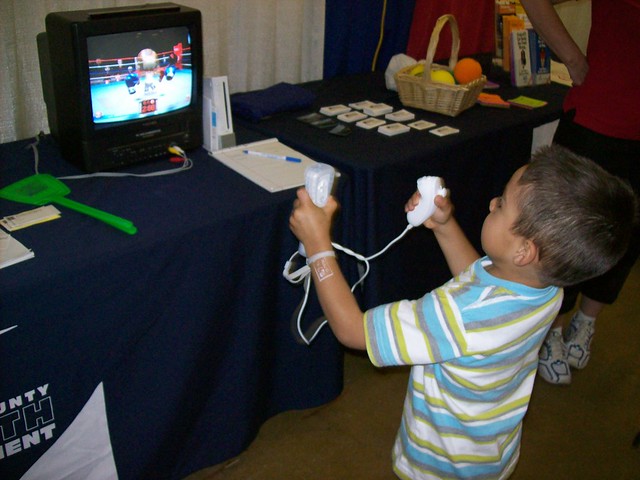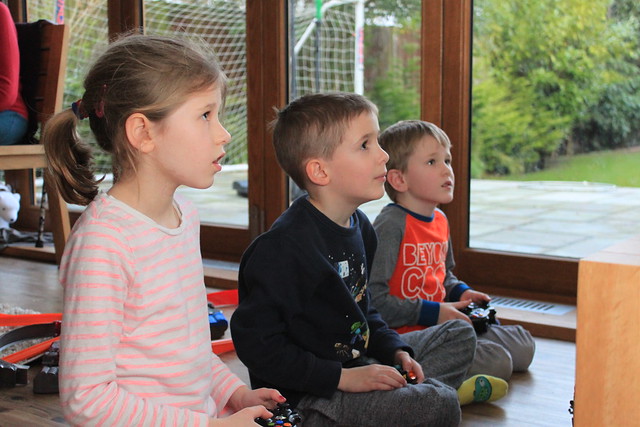Abstract
The main focus of this paper is to talk about violent video games and how they cause bad behavioral effects and aggression in children and teens. There will be a brief but fairly descriptive view on the history of video games from when the first known video game came out. The way video games have advanced greatly since the first game will also be talked about and what other games came out that affected the gaming industry in a positive way. Since the main focus is on violent video games it will be argued throughout the essay how violent video games are to blame for many things such as the tragedies that happened in the 90’s involving school shootings. Reviews from other people will also be included when talking about the controversial discussion that the first violent video game caused and how the public highly disliked it. The psychological role in this topic will be briefly explained as well. A big part of this essay will include the statistics taken in 2015 on how many people played video games and the studies that were done to prove that violent video games do result in bad behavior and aggression. This essay will conclude with how parents and others can help to reduce the amount of children and teens that play violent video games and how we need to make a better world for the future generation.
CCBY Jared Lindsay https://flic.kr/p/6HYM7u
Video games have been around for many years. People around the world have engaged with them since the time they came out and are still even playing them today. Out of the many different genres of video games, the one that brings up the most discussion are the violent ones. There has been an ongoing debate for years about whether or not violent video games cause bad behavioral effects and aggression. There is no number on how many different games include shooting, killing, and/or fighting. As a very popular game genre, it is very normal to think that it is a bad influence on innocent viewers and players. With the addictiveness that it brings and the amount of hours put into some violent graphics it isn’t hard to think that manipulative people, mostly children and teens, mimic these type of actions and aggressive behaviors. People who are around this fighting and violence are a lot more susceptive to act like that in the real world, away from the video game world where it would be acceptable to act in such a way. Bad behavior and aggression in children and teens is common to acquire when they play violent video games. There must be something done before it starts to affect the future generation for our world.
The world of video games include many different genres. Adventure games are one kind of genre that is out there (GamePeople, 2006). This type of game involves tactics and strategy skills to conquer the levels (GamePeople, 2006). Fighting games are another genre that requires a lot of physical combat and for the person playing to have a lot of control over the virtual character they are playing as (GamePeople, 2006). Racing is a driving style game where players race in either a fantastical arcade game or a very realistic aspect of driving (GamePeople, 2006). The rhythm and action category includes a lot of movement with either dancing, playing an instrument, or even singing (GamePeople, 2006). Another type of game genre that involves violence and combat is the shooter category. The players are expected to conquer each level by shooting their way out and defeating their opponent with fighting based tactics (GamePeople, 2006).
Out of the many different genres of video games there are in this world the ones that should be mostly focused on and paid attention to are the violent games. The reason that it is the violent video games instead of any other ones is because they involve a lot of virtual action with use of illegal weapons, killing, combat and it even makes the player feel like they are in control of everything (Gimpel, 2013). When you compare this to the other genres you see a very drastic change in the way they are played and how they make the player feel. For example, if you win at a racing game you feel joy and excitement for beating your opponents in the race but if you win in a fighting game by killing off your opponents you would feel a sense of empowerment because you won by killing.
CCBY Aslm Saeed https://flic.kr/p/eagi6f
The topic of concern here is how violent video games affect children and teens’ behavior by playing them. This topic is important to me for various reasons. The major one is because psychology plays a huge role in this which would be interesting to know for my major in psychology. Another reason is for me to know the effects of violent video games so that I am well aware of what can happen if I play them or even when my friends, family members or when my future kids want to engage with it. Lots of research has been done to prove that children and teens’ behavior change when they play these violent games but knowing other information like the history of video games and the ratings of them are important too.
Video games go back quite some time. The first video game was invented in 1958 at the Brookhaven National Laboratory located in Upton, New York (Kudler, 2000-2016). This video game was invented by physicist Willy Higinbotham (Kudler, 2000-2016). He created a table tennis game which involved two players who would turn a knob to adjust the ball’s angle and push a button to hit the ball towards the other player (APS News, 2016). As more and more people played this game it got so popular that there would be long lines of people waiting their turn to play (APS News, 2016). This game later became known as Tennis for Two and is thought to be the first video game invention ever (APS News, 2016). Video games have come a long way since then.
From the time when the Tennis for Two game came out, video games have greatly advanced. The first arcade game Computer Space came out in 1971 which the public said “it was too difficult to play.” Tetris was a very famous game that we still sometimes hear of today. It first came out in 1985 by Alex Pajitnov a Russian programmer. This game got a rating of 4.5/5 stars and some people said they “have been playing Tetris for over 20 years without regrets of buying it.” Pac Man, a favored video game by the public back then, sold over 300,000 units worldwide by Namco in 1980. The reviews this game got were unbelievable. Most said that this game was highly addictive and “it is certainly in the top 5.” Others even said “the graphics and gameplay were simply excellent.” The more video games advanced each year around the world the more people bought them. By looking at the reviews from these games, it seems that most, if not all, people enjoyed them. Not only did the gaming industry advance by coming out with new games every couple of years, but they also started came out with gaming consoles that made the gaming industry even more money.
CCBY Ama In Washington https://flic.kr/p/5bqJT7
Odyssey was the first home video game system that came out in 1972. This gaming console was a huge invention because it was the first home video game system that allowed people to play video games from the comfort of their own homes rather than going to an arcade. After this invention many other gaming consoles and devices originated and caught the public’s attention fast. A very popular console that we all know called the Play Station became a huge hit in 1995 where every console was sold for $299 each. It became known that the “play station is considered by many in the industry as most popular game console as the 20 millionth unit is sold.” This showed how much attention the gaming industry got and how popular it became since the Tennis for Two game came out. The invention of the multiple gaming consoles that have originated are a big reason for how many more people were getting into video games because they had the option of owning their own console and playing right from their homes. This was a good thing for the gaming industry because of how much money it made them but it also encountered some problems.
It wasn’t until the first violent video game outbreak that people started getting concerned. In 1976 a game that caused a lot of controversial discussion was Death Race. The way to win at this game is by running over as many gremlins as you can while having a limited time to do so. This game was not like the other games because this contained violent action and minor killing when the player had to run over the gremlins. The reason people got so upset over this game is because every time someone got hit they would hear an ‘ahhhk’ sound and a gravestone would pop up. This was one of the least favored games by the public and caused it to be taken off the market eventually. Another game that caused some controversy was Night Trap which was banned in 1993. The public spoke of this game as “shameful”, “ultra-violent”, “sick”, and “disgusting” because the main goal of this game was to save the women from harm but it caused the players to trap and kill them. Comparing the reviews from these violent video games to the non-violent ones there is clearly a huge difference. The comparison shows how badly the public reacted to the violent action in the games and how much attention should be paid to do something about it.
The major reason for people being so into video games is because of how addicting it is. There are five main factors that make a video game addicting. The first one is high score. When a game has a high score it is easy to get hooked on it because you will want to keep playing until you beat your high score. Some may even decide to keep going from there which can result in the player playing the game for hours in one day. Beating the game is the second factor. A game that has a certain amount of levels or tasks for you to complete until the final one is a great example. This will make the player potentially want to keep playing until they have gotten through every level possible and finally beat the game. The third factor is role-playing where the person plays as a character in their game and eventually forms some type of emotional attachment to them which makes it harder to stop playing. The discovery factor can be very compelling to a player when they discover a new world like in World of Warcraft. The final factor that makes a video game so addicting are the relationships they form when playing with other players online. Video games are a big hit because of the way it engages the people playing them and how it makes them feel. Anyone, even myself, can truthfully say that winning, whether it’d be in a sport, contest or in this case a video game, is always a rewarding feeling. It makes the winner feel like they have accomplished a goal and leaves them with feeling very satisfied about themselves.
CCBY KROCKY MESHKIN https://flic.kr/p/kHmtZ3
There are a lot of people in this world that play video games a lot. To be more specific roughly 155 million Americans played video games in 2015 (ESA, 2015). Statistics taken in 2015 show that out of the 155 million Americans, 56% are male and 44% are female players (ESA, 2015). Apart from the gender statistics there are also the age differential statistics. With the ages of 18 and under, there are 26% that play video games (ESA, 2015). The percentage of ages 18-35 years old is 30%, 38-49 years old is 17% and ages 50 and over is 27% (ESA, 2015). Knowing the statistics of how much people play video games is important because it allows us to see who is playing them more. The highest percentage in the age groups are ages 18-35. The ages of 18 and under and 50 and over are in the next top two percentages of people playing video games. This means that people in these age groups are engaging in video games more than the other age groups and therefore that would show where the focus age of the problem is in. Age is very important to know because when a game rating is questioned, only certain games are appropriate for certain ages which some people do not take into consideration.
In order to decide which ages can play which games there must be a rating system. In 1994 the Entertainment Software Rating Board (ESRB) was created. The Entertainment Software Association established this rating system to assign age and content rating to any games. This system is voluntary for games to approve of getting rated but most of them do rate their games because retail stores did not approve of selling games without a rating. The ratings by the ESRB are E, E10+, T and M (ESA, 2015). The E rating stands for everyone which means that anyone can play it (ESA, 2015). The rating E10+ stands for everyone 10 years of age and older that can play that game (ESA, 2015). The T rating stands for teens which are ages 13 and up (ESA, 2015). The M rating stands for mature which means only adults can play which are the ages of 17 and older (ESA, 2015). The ratings are important to know about when deciding who can play certain video games based on their age. Having the ESRB ratings helped a lot because it was able to inform the public of which games were appropriate for children and teens to play. However, there were even bigger problems that struck in America and violent video games were to blame for it.
The violent video game industry got off to a pretty bad start when there was controversial discussions on it and when some of the games had to be banned because of the public complaining about them. Since then, video games continued to advance and be played by the public because there were a lot of people that still enjoyed them while others did not. No attention was being paid about the bad behavior that gamers were acquiring, especially teens and early adolescents, until a terrible tragedy outbreak. In Paducah, Kentucky at Heath High School in December of 1997, Michael Carneal, fourteen years of age, killed three students at his school and harmed five (Gimpel, 2013). On March 14, 1998 at Westside Middle School in Jonesboro, Arkansas Mitchell Johnson, age 13, and his cousin Andrew Golden, age 11, killed five people and injured ten (Gimpel, 2013). In the same year on May 20 and 21 Kipland Kinkel, age 15, killed both of his parents in Springfield, Oregon (Gimpel, 2013). He then went to Thurston High School where he killed two people and harmed 22 (Gimpel, 2013). The common characteristics that all of these tragedies share are the games that each child engaged with.
CCBY Merrlll College of Journalism’s Press Releases https://flic.kr/p/8BdEgr
It was found that each of these three cases were connected with the teens and children all being violent video game fanatics. Michael Carneal enjoyed playing Quake, Doom and Redneck Rampage which involves the player to shoot and kill (Gimpel, 2013). Mitchell Johnson was a fan of the game Mortal Kombat where the goal of the game is for players’ virtual characters to “fight to the death.” Kipland Kinkel liked to play Doom where the player must shoot a gun at the monsters and villains (Gimpel, 2013). The outbreak of these tragedies raised major awareness and concern because of how violent these actions were and how young the children were that committed these crimes. This alerted not only the children and teens’ families but it also alerted the media, the newspapers and President Bill Clinton.
After the various and consecutive killings and harmful events, the concern for whether violent video games were to blame caused a huge debate. The Rocky Mountain News published an online story stating that the killers in the school shootings always engaged in violent games (Gimpel, 2013). United States President Bill Clinton at the time spoke to the media about the link between violent behavior and violent video games (Gimpel, 2013). He also mentioned a psychologist named David Grossman who stated that “video games teach children to kill like military training programs do” (Gimpel, 2013). Bill Clinton also advised parents in America to refrain from buying their children violent games and asked if the media could decrease the amount of violence action in movies, TV and even video games (Gimpel, 2013). This was one way of making everyone realize what the violent media is causing and is giving them an option to do something to stop the violent crimes happening in the world due to video games. However, there were still other problems to handle. Not only did the outbreak of killings and school shootings occur but there were also problems that other people were still encountering like bad behavioral effects and aggression.
A study done at Iowa State University involved researchers to pay attention to the way children acted after playing violent video games. They found that children who play video games at a young age are learning thought patterns that will continue to stick with them as they get older. According to the researchers “over time children start to think more aggressively.” Children also will react the way that they do in a video game when they are in a situation of being provoked. This means that if the child hits something in a video game when they get mad, chances are that they will make that same action in a real-life situation. Knowing this information, the researchers then did a study involving different age groups that played video games and recorded their behaviors.
The study used over 3,000 children to gather information which took over the course of three years. The children were between the grades of third, fourth, seventh and eighth. During the time of this study researchers recorded the amount of time the children would play the video games, the violent content in the game they were playing and how the child’s behavior would change. The results were that the boys’ ended up being more physically aggressive and spent more time playing the violent games than girls did but both genders showed the same behaviors. The researchers stated “gender and age really don’t affect this relationship between video game play, aggressive thinking and aggressive behavior.”
CCBY Jon Worth https://flic.kr/p/jNZNp
Another study used 161 participants between the ages of 9-12 and also used 354 college students (Anderson, Gentile, Buckely, 2007). Each participant in this study was either assigned to play a violent or nonviolent game (Anderson, et al., 2007). There was also information gathered about the participants themselves like what their game, television and movie habits were and also their recent history of violent behavior (Anderson, et al., 2007). The results from this study were just about what the researchers expected. They found that “the participants who played a violent game punished their opponents with significantly more high-noise blasts than those who played the nonviolent video games” (Anderson, et al., 2007).
A third study was done to focus on the General Aggression Model. The researchers gave out surveys to 189 high school students and the surveys included “measures of (1) violent TV, movie and video game exposure, (2) attitudes towards violence, (3) personality trait hostility, (4) personality trait forgiveness, (5)beliefs about how normal violence is, and (6) their frequency of various verbally and physically aggressive behaviors” (Anderson, et al., 2007). The researchers found that adolescents who engage more into violent games do show “more pro-violent attitudes, have more hostile personalities, are less forgiving, believe violence to be more typical, and behave more aggressively in their everyday lives” (Anderson, et al., 2007). They also found that violent video games were somewhat a cause of physical aggressive behavior and also violent behavior (Anderson, et al., 2007).
Lots of research has been done to determine whether or not violent video games are the cause of bad behavior and aggression. Looking back at the results from all three of the studies done they were all pretty similar. The study done in Iowa state concluded that although the boys did show more physical aggression and played violent video games more than the girls did the gender did not matter because both behaviors were the same from playing the games. The second study concluded that the participants who played the violent games punished their opponents in a cruel way compared to the other participants who played the nonviolent games. The third study concluded that the participants who also played the violent games showed behaviors of being less forgiving, hostility, violent acts, and were more aggressive in their everyday lives. These results prove how serious these effects are and they can just become even worse if the affected people don’t seek some sort of help.
Luckily there is a lot of help options out there for people to get when they are experiencing these behaviors. That is where psychology comes into the picture. As a psychology major I know that the job of the psychologist is to analyze and record the behavior of a patient they are treating. The psychologist would see what behaviors the person shows, write them down on a piece of paper and then at the end of the session they would analyze it and get the result. The result would be what disorder the person is experiencing and then the psychologist would give the patient treatment options such as behavioral therapies, psychoanalytical and psychodynamic therapies, humanistic therapies and arts therapies. In the case of violent video games causing bad behavior and aggression the person would most likely get the behavioral therapy because it focuses on cognitions and behaviors. The psychologist plays a huge role in this topic of violent video game effects because they are the people who can help prevent further problems down the road and help treat the problems that children and teens are facing now. Not only can the psychologists do something to help this problem but the parents can too.
CCBY Ian Turk https://flic.kr/p/CyCKpq
Believe it or not, parents are a huge factor when it comes to children and teens playing a certain video game because the parent always must approve of it first. Some parents will allow their child to play any game without knowing the content of the game and other parents will not allow their kid to play any games they do not approve of because of how inappropriate it is. In an article by Dr. Phill called Parenting he gives some great tips and advice on what parents should do when allowing their children to play a certain game they’re unsure of. The first tip he gives is that parents should always first check the rating of the game to make sure it is in their child’s age range. They should also monitor the way their child acts after playing a game that may be too violent or inappropriate for them so they can decide whether or not to let them keep playing it. Communicating with other parents is also is a good idea so they can give you their own feedback. Having the parents play the game with their child is another great tip because it will allow them to see how the game is played and also see how their child acts when playing it. If these precautions are taken before allowing children and teens to engage with certain video games it can be sure to decrease the amount of aggressive and violent behaviors they acquire when they do play violent video games.
The reason others should be interested in this topic of concern is because this is something to be worried about for the future of our kids. If more people have knowledge about how they can affect your behavior then they will be sure to do something to avoid that. They can also advise people who do play violent video games about the bad side effects that comes with playing it so they can tell them to stop before it gets worse. The more people that are aware of this important topic the more that can be done to prevent problems further down the road that some people are already facing today. Violent video games are a problem and will only get worse if it is not brought up in a concerning topic of discussion.
While video games keep advancing, children and teens will continue to play the new games that come out each year. Although there are ratings to help with allowing certain children and teens to play certain games, that is still not enough to prevent the behavioral effects and aggression that they keep acquiring. Parents need to step up and control exactly what they are letting their child watch and play. Others must be informed of this topic so they can also be aware of how harming these violent video games are. With the proof of the many studies done in the past there is no doubt that violent video games are to blame for the tragedies that have happened and for the effects children and teens are acquiring from playing these games. Informing others about this topic can do more good than bad. The next step to solving this problem is to decrease the amount of harm that violent video games are causing and to increase a better future for the next generation.
CCBY JackBrookes https://flic.kr/p/rvB5e8
References
Anderson, C. A., Gentile, D. A., & Buckley, K. E. (2007). Violent video game effects on children and adolescents: Theory, research, and public policy. Oxford: Oxford University Press.
APS News. (2016). This Month in Physics History. Retrieved May 2, 2016, from https://www.aps.org/publications/apsnews/200810/physicshistory.cfm
A Timeline of Video Game Controversies. (2010, October 31). Retrieved May 2, 2016, from http://ncac.org/resource/a-timeline-of-video-game-controversies
Dr. Phil. (2015). Parenting. Children and Violent Video Games. Retrieved May 3, 2016, from http://www.drphil.com/articles/article/297/
ESA. (2015). 2015. 2015 Sales, Demographic and Usage Data, 5(1), 12-13. Retrieved May 5, 2016, from http://www.theesa.com/wp-content/uploads/2015/04/ESA-Essential-Facts-2015.pdf
GamePeople. (2006). Video Game Genres. Retrieved May 2, 2016, from http://www.gamepeople.co.uk/genres.htm
Gimpel, D. M. (2013). Violence in video games. Minneapolis, MN: ABDO Publishing Company.
Iartronic, & Gangstahippie. (2006). Pac-Man. Retrieved May 2, 2016, from http://www.imdb.com/title/tt0260264/reviews
Iowa State Researchers. (2014). Life lessons: Children learn aggressive ways of thinking and behaving from violent video games. Retrieved May 2, 2016, from http://www.news.iastate.edu/news/2014/03/24/violentgamesbehavior
Kickinthehead. (2011). Tetris. Retrieved May 2, 2016, from http://www.giantbomb.com/tetris/3030-1896/user-reviews/
Kudler, A. (2000-2016). Timeline: Video Games. Retrieved May 2, 2016, from http://www.infoplease.com/spot/gamestimeline1.html
Memiah Limited. (2016). Types of Therapy. Retrieved May 2, 2016, from http://www.counselling-directory.org.uk/counselling.html
Video Game Addiction. (n.d.). Retrieved May 2, 2016, from http://www.video-game-addiction.org/what-makes-games-addictive.html








I tend to fall down on the other side of this debate (not exactly in favor of violent video games, but skeptical about censorship efforts or causation arguments), but your essay is very persuasive and thorough. I found a lot of the studies you cited very interesting, and I also really enjoyed the historical background your provided. A great read– thank you! More notes in Hypothesis, too…
LikeLiked by 1 person